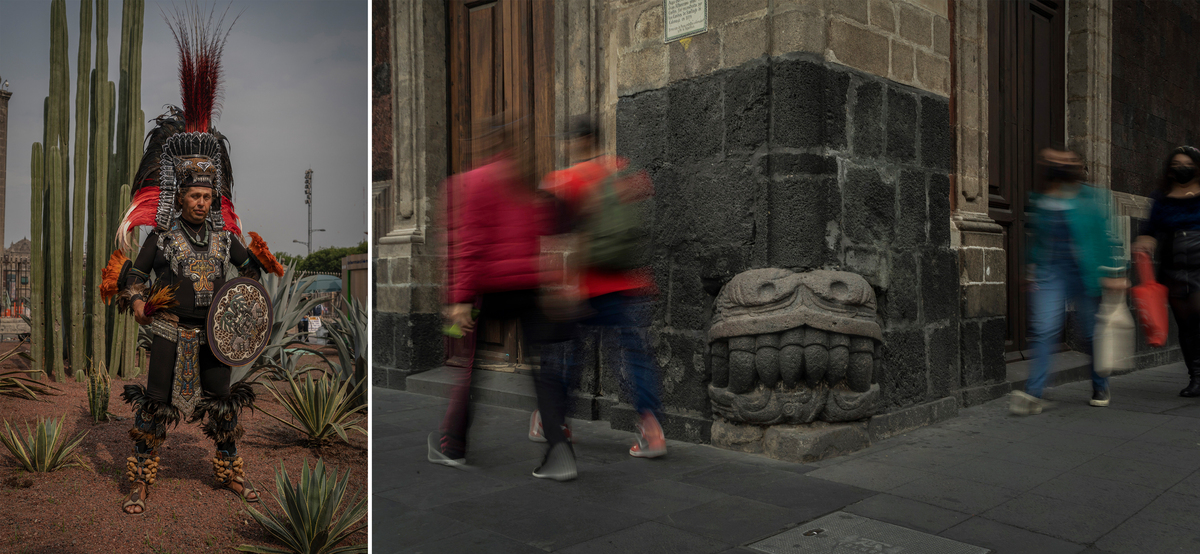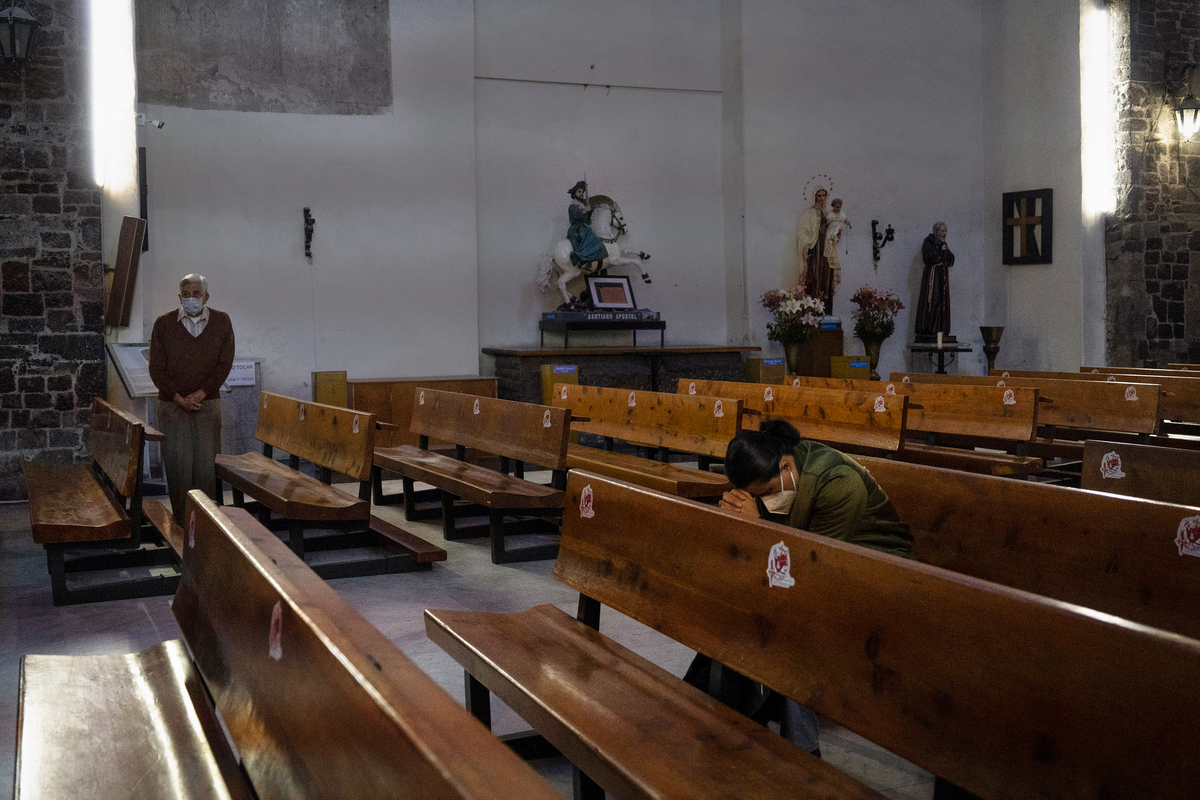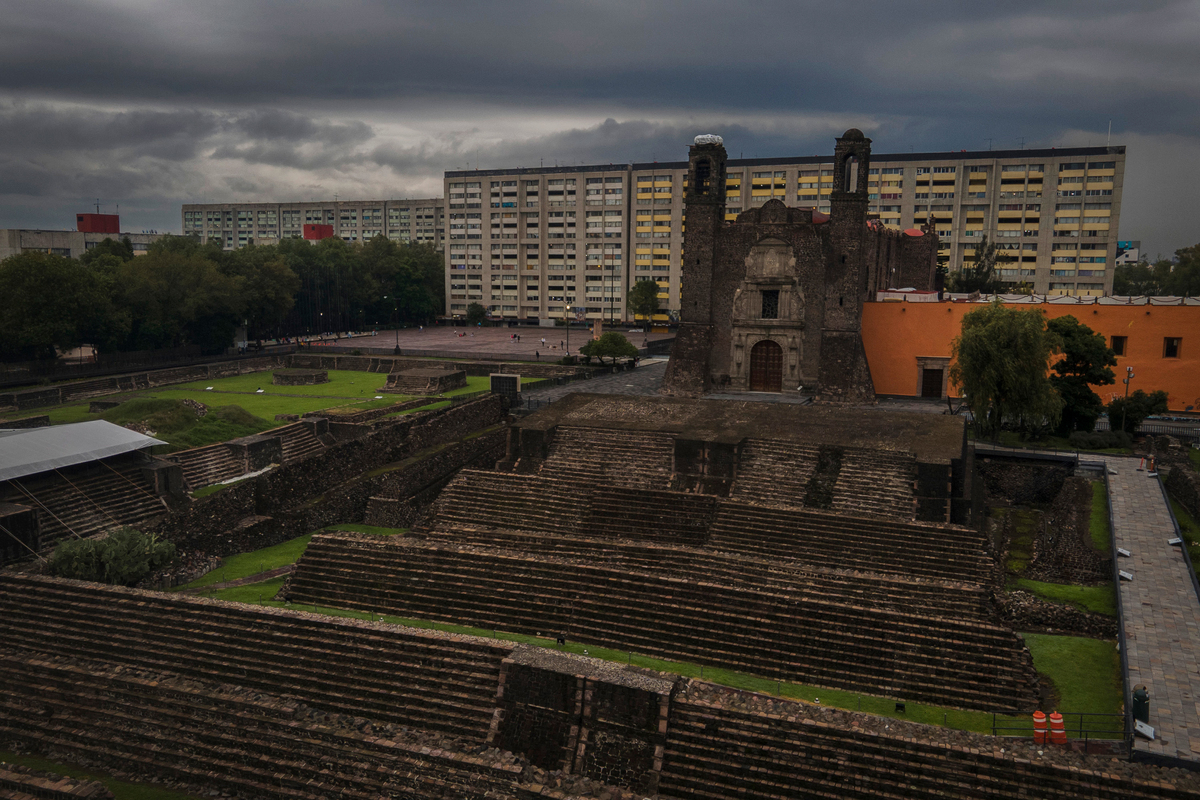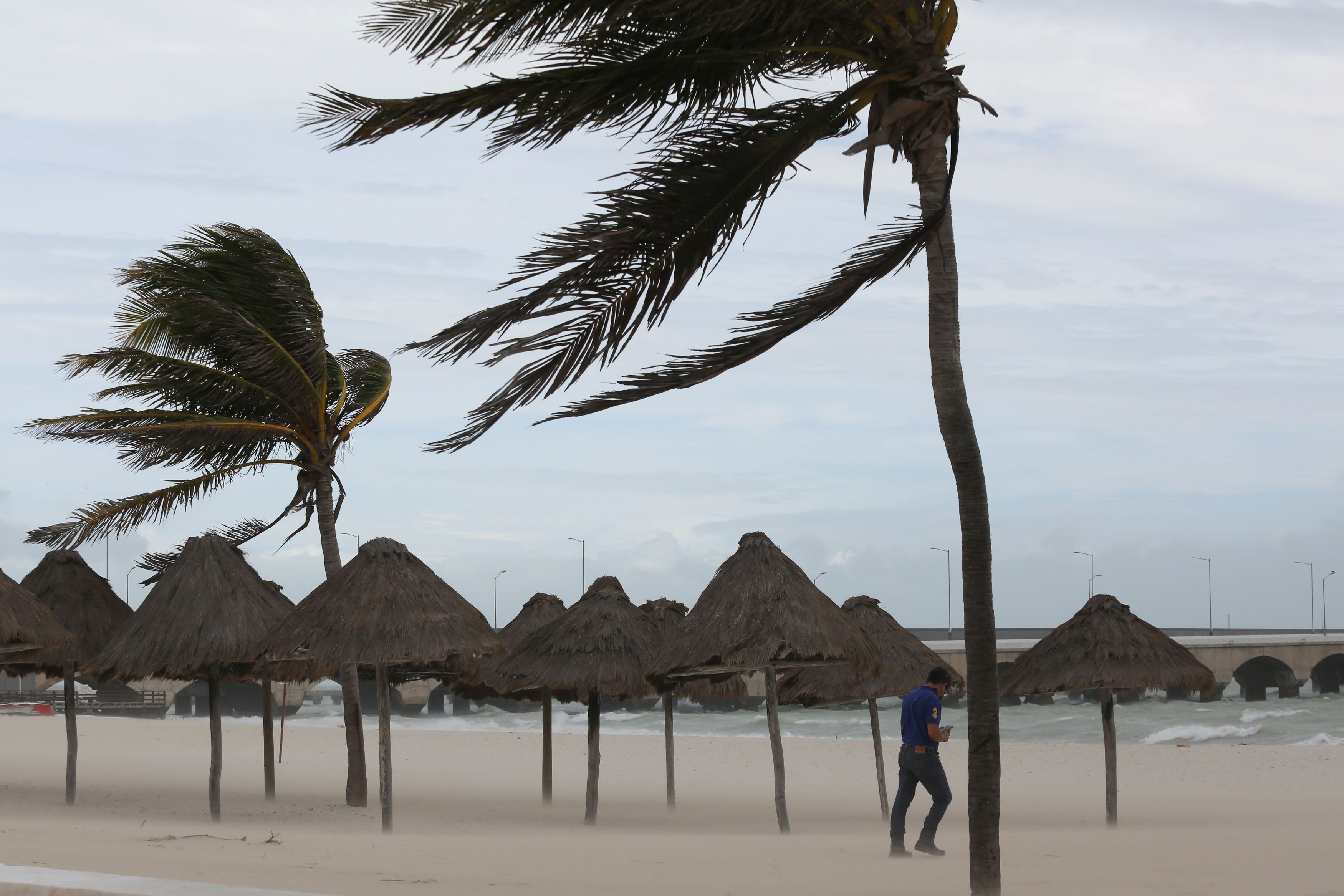[ad_1]

Three Mexican farmers, called chinamperos, navigate a trajinera, a small traditional boat of the area, through water canals on Xochimilco Lake, Mexico, in June.
Victoria Razo for NPR
hide caption
toggle caption
Victoria Razo for NPR

Three Mexican farmers, called chinamperos, navigate a trajinera, a small traditional boat of the area, through water canals on Xochimilco Lake, Mexico, in June.
Victoria Razo for NPR
MEXICO CITY — These days the Mexican capital is a top spot for travelers eager to emerge from coronavirus lockdowns. The megalopolis has long lured tourists with its mix of modern and ancient, and this summer, there’s even more history to entice: Mexico is marking 500 years since the Spanish conquistadors, and their Indigenous allies, laid siege to the city, leading to the downfall of the Aztec Empire.
While most tourists visit the twin pyramids of Teotihuacán, outside the capital, or the city’s Templo Mayor, there are several sites off the well-worn path where visitors can get a glimpse of what the area was like before the Spanish arrived.
The best view is from a canoe.
“This is how Mexico City used to look,” says historian Santiago Sosa-Salazar, paddling through one of the city’s last bodies of water. This network of canals is part of a 400-acre ecological park in Xochimilco, in the far south side of Mexico City.

Left: Santiago Sosa-Salazar, 29, a historian specializing in the conquest. Right: A heron flies over the canals of Xochimilco Lake.
Victoria Razo for NPR
hide caption
toggle caption
Victoria Razo for NPR

Left: Santiago Sosa-Salazar, 29, a historian specializing in the conquest. Right: A heron flies over the canals of Xochimilco Lake.
Victoria Razo for NPR
Canoeing back through history
The canoe winds around slender islands covered in thick grasses and native ahuejote, a type of willow tree. Tall white egrets, stout brown hawks and other waterfowl perch on the banks.
Five hundred years ago, there was plenty of fresh water in the Valley of Mexico. And a great civilization was thriving atop the myriad of lakes. It was known as Tenochtitlán. By the early 16th century, it was home to more than 200,000 people. To feed them all, the Aztecs built artificial islands with the fertile soils of the lake bed.

Partial view of Lake Xochimilco, where the last remnants of the extensive transportation system created by the Aztecs are located.
Victoria Razo for NPR
hide caption
toggle caption
Victoria Razo for NPR

Partial view of Lake Xochimilco, where the last remnants of the extensive transportation system created by the Aztecs are located.
Victoria Razo for NPR

An Italian rendering of Tenochtitlán from 1528.
Picturenow/Universal Images Group via Getty Images
hide caption
toggle caption
Picturenow/Universal Images Group via Getty Images

An Italian rendering of Tenochtitlán from 1528.
Picturenow/Universal Images Group via Getty Images
The islands, called chinampas, are still producing, says 58-year-old farmer Martín Cabrera, as he hoes at weeds on one of the thin strips of land.
“This is where our ancestors farmed and pretty much we’re doing it the same way,” he says. as he stretches his back a bit before bending over again to hoe out weeds.
Cabrera works with Humedalia, a group that fights to preserve Xochimilco’s farms and offers tours of the area.

Francisco Juarez (left), an environmental educator with the Humedalia association, serves as a local guide for tourists visiting the chinampas at Xochimilco Lake.
Victoria Razo for NPR
hide caption
toggle caption
Victoria Razo for NPR
Not only did these waters feed and fuel the Aztec Empire, they were also a natural barrier to enemies. And the Aztecs had many. Indigenous groups resented paying levies to the rulers. According to Sosa, who specializes in the conquest, when conquistador Hernán Cortés came over the mountains abutting the city in 1519, he took full advantage of the Aztec’s disrepute.
“The impressive thing about Cortés is that he didn’t speak a word of Maya or Nahuatl. He speaks Spanish and he managed to get all these groups to fight against the Aztecs,” Sosa says.
Moctezuma, the Aztec ruler at the time, was no fool either, says Sosa. He thought diplomacy was a better bet over war and let Cortés inside Tenochtitlán.
Moctezuma was eventually killed — just how is a big debate — but the Aztecs went on to drive Cortés and his army out.
However, Cortés’ army would regroup and fight the Aztecs, whose numbers were severely reduced by smallpox, brought by the Spanish. Their biggest battle came in the summer of 1521, not far from modern day downtown.

A sculpture of Tlaloc, god of water and rain in different Indigenous cosmogonies, was completed by artist Diego Rivera in the early 1950s at the site of one of the main spots where water comes into the city. The Spanish cut off water to the Aztecs during their summer-long siege of 1521.
Victoria Razo for NPR
hide caption
toggle caption
Victoria Razo for NPR

A sculpture of Tlaloc, god of water and rain in different Indigenous cosmogonies, was completed by artist Diego Rivera in the early 1950s at the site of one of the main spots where water comes into the city. The Spanish cut off water to the Aztecs during their summer-long siege of 1521.
Victoria Razo for NPR

Left: A dancer poses in Aztec costume, in the Zócalo of Mexico City. The dance is meant to honor the gods and form a link with the cosmos. Right: A head of Quetzalcoatl, the feathered serpent, one of the most important gods of Mesoamerican culture, is seen at the base of a colonial building in downtown Mexico City.
Victoria Razo for NPR
hide caption
toggle caption
Victoria Razo for NPR

Left: A dancer poses in Aztec costume, in the Zócalo of Mexico City. The dance is meant to honor the gods and form a link with the cosmos. Right: A head of Quetzalcoatl, the feathered serpent, one of the most important gods of Mesoamerican culture, is seen at the base of a colonial building in downtown Mexico City.
Victoria Razo for NPR
Mexico City on two wheels
While the bustling city may not seem conducive to bike riding, biking is a fun way to visit many tucked away sites. And on Sundays, the city closes down many major boulevards, safeguarding riders from Mexico City’s not so safety cautious drivers.

Cyclists enjoy a car-free Sunday ride around the statue of Cuauhtémoc, the last Aztec emperor, in Mexico City. The monument displays names including Cuitláhuac, who was his predecessor who also fought against the Spanish.
Victoria Razo for NPR
hide caption
toggle caption
Victoria Razo for NPR

Cyclists enjoy a car-free Sunday ride around the statue of Cuauhtémoc, the last Aztec emperor, in Mexico City. The monument displays names including Cuitláhuac, who was his predecessor who also fought against the Spanish.
Victoria Razo for NPR
Reforma Boulevard teems with bike riders, joggers and skaters, easing the usually frenetic pace of Mexico City, and making it easier to check out some of the street’s impressive statues. The one at a usually busy intersection on Reforma is of a warrior, wearing a ceremonial robe, holding a spear and towering over the street below.
“That is Cuauhtémoc. You can see the crown, it resembles the eagle feather. Cuauhtémoc means in Nahuatl fallen eagle,” Sosa says pointing to the statue.
Cuauhtémoc was the last Aztec emperor to battle Cortés — 500 years ago this summer. They fought at a site 2 miles from the statue, along the bike route, in what is now the Plaza of Three Cultures. It is filled with three structures symbolizing Mexico’s past and present: a modern office building, Aztec temple ruins and a Spanish colonial church.
Historian Sosa says Cortés pledged to Santiago — Spanish for St. James — that he would build a church on the site if he won the battle.
“And he kept his promise and here we have the Church of Santiago,” he says. On a Sunday, taking a break from the bike ride, one can dip into the main sanctuary and attend Mass or just cool off inside and reflect on the history of the site while sitting on the wooden pews.

A woman prays inside the Catholic Church of Santiago Tlatelolco.
Victoria Razo for NPR
hide caption
toggle caption
Victoria Razo for NPR

A woman prays inside the Catholic Church of Santiago Tlatelolco.
Victoria Razo for NPR
What gets lost in many versions of Cortés’ conquest is that Spaniards made up only 1% of the conquering army, according to historians. Most were Indigenous rivals of the Aztecs.
A plaque at the site commemorates the final battle of the conquest as a pivotal point in Mexico’s destiny and its identity. A portion of it reads:
Neither triumph nor defeat
it was the painful birth of the mestizo people
that is the Mexico of today

Sosa says Mexico’s history is more complicated. Mexicans are not all mestizo, or mixed race — part Spanish, part Indigenous.
And some Mexicans are offended by versions of history that minimize present-day native cultures. “They are overly romanticizing our history,” says passerby Luisa Muñoz.

View of the archaeological ruins of Tlatelolco, in front of the Church of Santiago, one of the first to be built after the Spanish conquest. This site preserves elements of pre-Hispanic times, in what is now known as the Plaza of Three Cultures.
Victoria Razo for NPR
hide caption
toggle caption
Victoria Razo for NPR

View of the archaeological ruins of Tlatelolco, in front of the Church of Santiago, one of the first to be built after the Spanish conquest. This site preserves elements of pre-Hispanic times, in what is now known as the Plaza of Three Cultures.
Victoria Razo for NPR
In fact, the conquest set in motion centuries of subjugation and discrimination for the country’s indigenous. This makes commemorating the 500th anniversary of that last battle painful to many.
Attempting to reckon with that turbulent past, city leaders have spent the summer removing conquistador names from roadways and other sites, and replacing them with Indigenous ones.
Like many other places in the world these days, Mexico is still wrestling with its history.
[ad_2]
Source link














